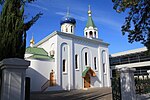Electoral district of Sturt (South Australia)
1857 establishments in Australia1902 disestablishments in Australia1915 establishments in Australia1938 disestablishments in AustraliaFormer electoral districts of South Australia
Sturt (The Sturt until 1875) was an electoral district of the House of Assembly in the Australian state of South Australia. It was named after the explorer Charles Sturt. Sturt was one of the initial districts in the first parliament. It was initially centred on Unley, but later broadened to include all or part of Belair, Brighton, Glenelg, Goodwood, Hyde Park, Mitcham, Parkside and Sturt. When recreated in 1915, it also included Hawthorn and Wayville.
Excerpt from the Wikipedia article Electoral district of Sturt (South Australia) (License: CC BY-SA 3.0, Authors).Electoral district of Sturt (South Australia)
King William Road, Adelaide Unley
Geographical coordinates (GPS) Address Nearby Places Show on map
Geographical coordinates (GPS)
| Latitude | Longitude |
|---|---|
| N -34.95 ° | E 138.6 ° |
Address
Stop 4 King William Road - East side
King William Road
5061 Adelaide, Unley
South Australia, Australia
Open on Google Maps





